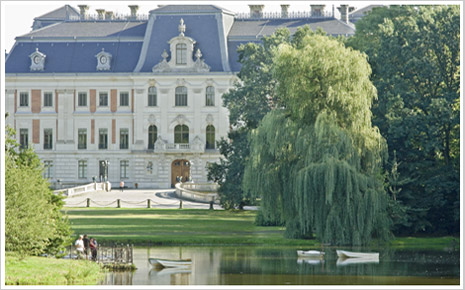- Przejdź do menu głównego ALT + 0
- Przejdź do treści ALT + 1
- Przejdź do wyszukiwarki ALT + W
- Mapa strony ALT + 2
Castle Museum in Pszczyna
 The Castle Museum is situated in the castle which used to be fortified and later was converted into a presentable three-wing mansion. The first castle in Pszczyna, according to Heinrich Schaeffer, a 19th-century Prince’s archivist and chronicler of Pszczyna, was probably erected in 11th or 12th century by the Piast princes. It was a single-wing building, surrounded with earth walls and a moat filled with water. It was used as a hunting palace also throughout the following centuries, until 20th century, as the neighbouring woods abundant in wild game were famous for hunting events. A masonry castle was constructed in Pszczyna only in 15th century. This was initiated by Helena Korybutówna, a niece of Vladislav Jagiello. This medieval castle was reconstructed and expanded several times in time. The last reconstruction, in the neobaroque, was carried out in 1871-1876 by an outstanding French architect Hipollyte Alexandre Destailleur (1822-1893).
The Castle Museum is situated in the castle which used to be fortified and later was converted into a presentable three-wing mansion. The first castle in Pszczyna, according to Heinrich Schaeffer, a 19th-century Prince’s archivist and chronicler of Pszczyna, was probably erected in 11th or 12th century by the Piast princes. It was a single-wing building, surrounded with earth walls and a moat filled with water. It was used as a hunting palace also throughout the following centuries, until 20th century, as the neighbouring woods abundant in wild game were famous for hunting events. A masonry castle was constructed in Pszczyna only in 15th century. This was initiated by Helena Korybutówna, a niece of Vladislav Jagiello. This medieval castle was reconstructed and expanded several times in time. The last reconstruction, in the neobaroque, was carried out in 1871-1876 by an outstanding French architect Hipollyte Alexandre Destailleur (1822-1893).
Contrary to the former long-lasting ones due to the shortage of money, this reconstruction was carried out with great impetus and without causing debts. In this form the castle can be admired today.
The castle in Pszczyna was ruled by the Piast princes from the line of Opole and Racibórz, Czech Premyslids from Opava, Hungarian family of Thurzo from Spisz, Silesian family of Promnitz from Żary, the Anhalts from Köthen and Hochbergs from Książ. It should be stressed that in Pszczyna, situated in the region influenced by numerous cultures, there coexisted the cultures of Poland, Czech, Hungary and Germany.
It was here that the decision on a total submarine war in the Atlantic Ocean was taken. This is discussed in detailed by American writer Barbara Tuchman in her documentary book entitled Zimmerman Telegramme (published in Poland in 1997). Also, Bogusław Wołoszański took interest in the war and referred to events taking place in Pszczyna. He discussed that in the book entitled Ten okrutny wiek (published in Warsaw in 1995) and he shot a documentary (in June 2000), being a part of the cycle called Sensacje XX wieku.